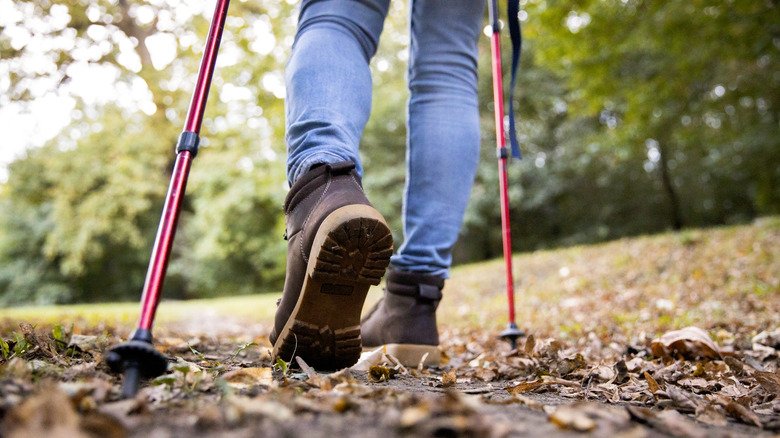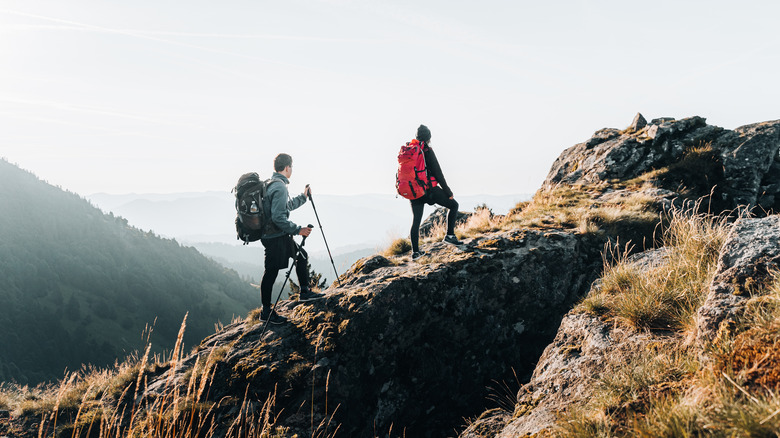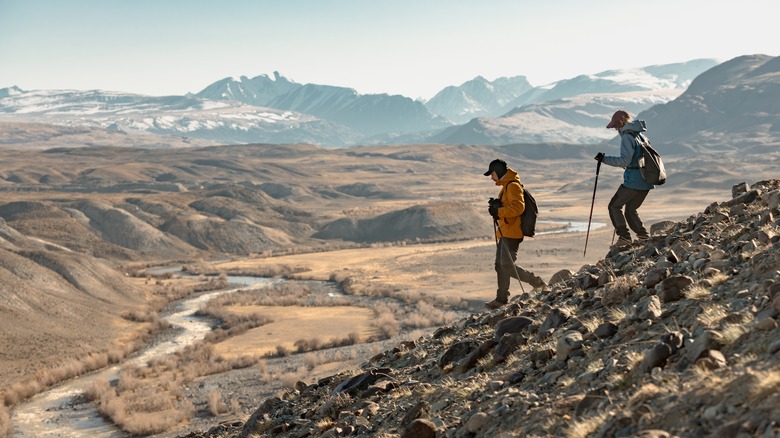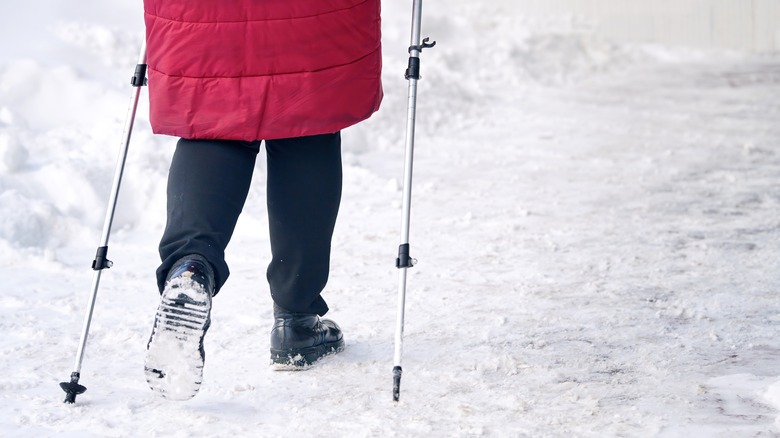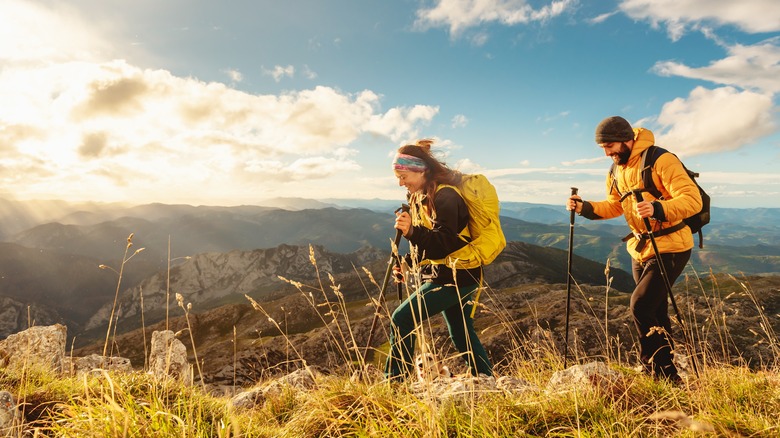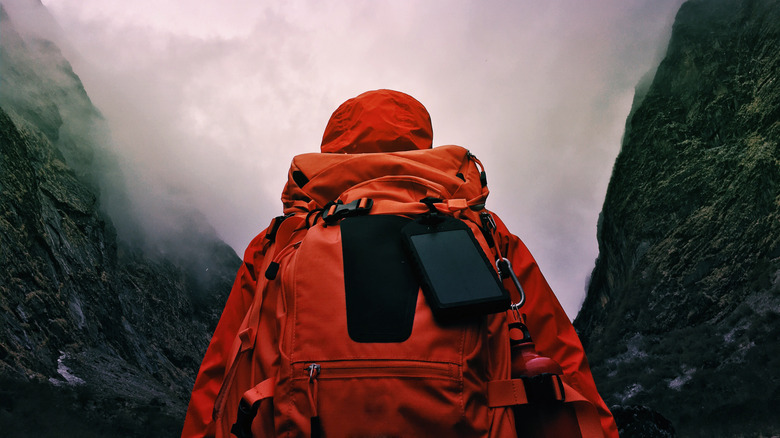Why You Should Bring A Trekking Pole On Your Next Hike
Embarking on a hike often involves careful consideration of gear, from sturdy boots to hydration packs. Among these hiking essentials, trekking poles might not initially spring to mind. After all, can't a simple stick found on the trail suffice? While this notion may hold some appeal, trekking poles offer a plethora of advantages that extend beyond the capabilities of a mere stick. These versatile tools, with their adjustable length, changeable bottom tips, and ergonomic design, provide stability, balance, and reduced strain on joints. Whether opting for a single pole or a pair, hikers benefit from enhanced support and endurance on varied terrains.
While trekking poles may not be deemed as indispensable as your trusty boots, they undoubtedly offer a suite of advantages, especially on certain types of hikes and terrain. In this article, we'll delve into why trekking poles stand out as more than just glorified sticks. Whether you're navigating rugged mountain trails or embarking on a leisurely stroll through the woods, understanding the benefits of trekking poles could transform your hiking experience.
Trekking poles help propel you forward on steep ascents
We all know that ascending steep inclines presents a significant challenge for the leg muscles. Trekking poles offer a solution by engaging the muscles in the arms and shoulders, distributing the workload between the upper and lower body. This effectively reduces strain on the leg muscles.
A study published in the European Journal of Applied Physiology highlights the critical role of trekking poles in navigating uphill climbs, especially on increasingly steep terrain. The study reveals a direct correlation between the intensity of pole usage and the terrain's steepness, with climbers exerting more force on the poles as inclines become steeper. But what does this increased dependence on poles imply for hikers' legs? The study reveals that the increased force exerted on the trekking poles effectively reduces the force that would otherwise burden the legs. Essentially, the force applied to the trekking poles serves to propel hikers forward and gain momentum during the uphill climb.
By leveraging upper body strength, hikers can push off the ground with each step, gaining additional propulsion. This enhanced efficiency not only assists in ascending slopes but also makes uphill climbs more manageable and enjoyable, ultimately propelling hikers forward with greater ease and speed.
They reduce joint strain when moving downhill
Descending steep slopes presents inherent risks, particularly concerning the strain it imposes on the lower body. The repetitive impact of downhill descent can lead to discomfort and potential injury, especially for individuals with knee or joint issues. However, recent research sheds light on an effective solution: trekking poles.
During downhill descents, use trekking poles as brakes to control your speed and reduce the impact on your knees and joints. Place the poles slightly ahead of your body and lean back slightly, allowing them to absorb some of the force as you descend. This technique helps maintain stability and prevents strain on your lower body.
A 2007 study published in Medicine & Science in Sports & Exercise examined the effectiveness of pole use during downhill hiking, especially when carrying heavy backpacks. They had 15 experienced hikers try different hiking conditions: using poles and not using poles while carrying different backpack weights. The results were pretty clear: trekking poles made a big difference. When hikers used trekking poles, there was a noticeable decrease in the pressure and strain on their ankles, knees, and hips, probably because some of the weight was distributed to the wrists and arms. By reducing the strain on your leg joints, trekking poles act as shock absorbers, dampening the impact and reducing the strain on your joints, minimizing the risk of injury in the middle of a hike.
They provide stability on uneven or slippery terrain
In technical terrain, such as rocky or root-strewn trails, trekking poles offer stability and balance by providing hikers with additional points of contact with the ground. This is particularly helpful when navigating obstacles, as the poles can be planted firmly with each step to establish a stable foundation, reducing the risk of slips and falls, which are actually common ways that people die in the wilderness. Trekking poles allow hikers to uneven surfaces, maintain their footing and traverse challenging terrain with greater security.
When crossing streams or traversing slippery surfaces, trekking poles play a crucial role in maintaining balance and stability. The adjustable length feature of trekking poles allows for customization according to the depth of the water, providing added versatility in stream crossings. By probing the depth and stability of the streambed and offering support on slippery rocks, trekking poles help hikers navigate water crossings safely and confidently.
Furthermore, trekking poles offer reassurance and confidence on muddy or boggy terrain. By adding mud baskets to the bottom of your poles, they won't easily sink into the soft ground, helping you stay upright and dry. Their technical features make them essential tools for hikers facing various obstacles and terrains during their outdoor adventures.
They reduce fatigue in your muscles during long-distance hikes
For long-distance hikes, when your legs are bound to get bogged down, trekking poles can be your saving grace, alleviating some of the weight your lower limbs bear and keeping you going longer. We already know that trekking poles help distribute the workload between your arms and legs, allowing your upper body to share some of the effort. By engaging your upper body, you can delay the onset of fatigue your legs experience.
But even beyond just your legs, as fatigue sets in during a lengthy hike, maintaining proper posture becomes increasingly challenging. The temptation to slouch or lean excessively can strain your back and lead to discomfort. Here's where trekking poles shine: they not only provide stability but also encourage an upright posture. By distributing your weight more evenly and providing additional points of contact with the ground, trekking poles help you maintain a straighter spine and avoid unnecessary strain on your muscles. This improved posture not only reduces the risk of discomfort but also enhances your overall endurance on the trail, allowing you to push through fatigue and keep moving forward with confidence.
They offset the weight of heavy backpacks
When you're out on a hike, it's not just the terrain and footing that can pose a challenge; it's also the weight of all the gear you're carrying. Even a perfectly packed backpack, one that has avoided all the mistakes that people typically make when packing for a hike, can become burdensome after a while. Fortunately, trekking poles can come to the rescue by helping offset some of that weight.
Carrying a heavy backpack for extended periods can take a toll on your body, particularly your back, shoulders, and neck. By distributing the load more evenly, trekking poles alleviate pressure on your back and shoulders, reducing fatigue and discomfort. This redistribution of weight enables you to hike longer distances with greater ease, allowing you to explore more of the great outdoors without feeling weighed down by your gear.
Even during breaks, I've found my trekking poles to be handy for situations when the ground is too dirty to place my backpack directly onto it. By using the trekking poles to create a makeshift support system against a sturdy surface like a tree or large rock, I can lean my backpack against the structure and adjust the straps to secure it in place. This not only takes the weight off my shoulders but also allows me to relax without the need to remove my backpack completely.
